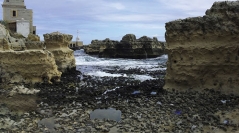

 Comptes Rendus Palevol
15 (5) - Pages 473-481
Comptes Rendus Palevol
15 (5) - Pages 473-481The fragmentary fossil history of whale barnacles (Cirripedia: Coronulidae) is mainly constituted by remains of Coronula spp. in Plio-Pleistocene deposits found along extant humpback whale migration routes, and especially in occurrence of breeding areas. Here we report the presence of a single compartment of Cetopirus along with remains of Coronula bifida in Lower Pleistocene open shelf deposits of Salento (South Italy). This is the first occurrence of the genus Cetopirus prior to the Late Glacial period (ca. 15–10 ky before Present), and the specimen here studied is designated as the holotype of the new fossil species Cetopirus fragilis. Since Cetopirus is currently found exclusively inhabiting the skin of the right whales (Eubalaena spp.), the fossil material here studied suggests the persistence of Balaenidae in the Mediterranean Basin during the Early Pleistocene and supports the existence of a baleen whale migratory route active between the central Mediterranean and the North Atlantic during the Plio-Pleistocene.
Whale barnacles, Cetopirus, Balaenidae, Mysticeti, Migration, Mediterranean Basin, Plio-Pleistocene